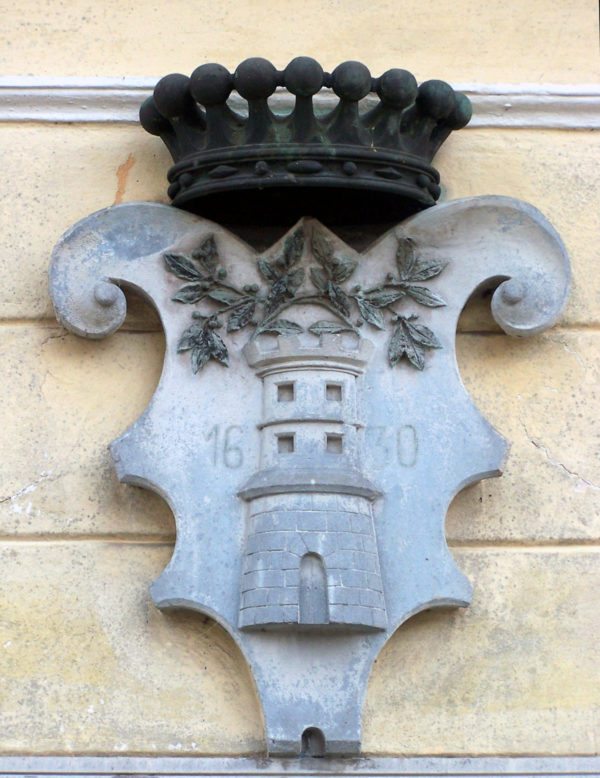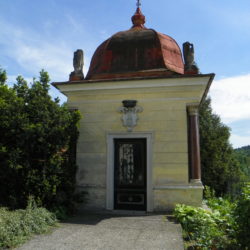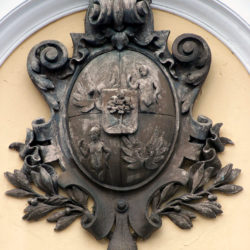
Coat of arms of the Counts Margheri-Commandona in Otočec
OTOčEC, CEMETERY
Location of the coat of arms: tomb
The cemetery in Otočec is dominated by the cemetery chapel and a stone structure displaying a coat of arms carved above its entrance. It is the tomb of the comital family Margheri-Commandona, which owned the castles at Otočec (Burg Wördl) and Stari Grad (Altenburg) in the second half of the nineteenth century and first half of the twentieth century. The Margheris’ early history is not entirely clear. Believed to have had their origins in Spain, they subsequently moved to what is now western Italy, where in 1630 (the year carved in their coat of arms on the tomb at Otočec) they obtained the following noble titles attached to the historical territory of Savoy: the primogeniture title Marchese di San Giorgio and the secundogeniture title Conti di Commandona. The subsequent Margheris of Otočec held the predicate Commandona because both the father and grandfather of the first Carniolan Margheri were second-born. The Margheris arrived in the Habsburg provinces from Piedmont at the end of the eighteenth century. Count Antonio Giuseppe enlisted in the Austrian army, where he earned the rank of colonel. Both his sons Clemens Antonio and Antonio Giuseppe were initially officers, and then the older Clemens left the army, settled in Ljubljana, and became a file clerk. By marrying Florentina Langer from Poganice near Novo Mesto, he became part of the Lower Carniolan nobility, enabling his descendants to establish their center in the wider area of Novo Mesto for more than a century. On her mother’s side, Florentina belonged to the Breckerfeld family, the owners of Stari Grad Castle near Novo Mesto. Because Isabela and her brother Adolf were the last representatives of their family, Stari Grad was inherited after their deaths by Isabela’s grandchildren: Florentina’s children Emilian, Albin, and Silvina Margheri.
The lineage thus only continued through the younger of the brothers, Albin, who married Josefa Countess von Coreth in February 1854. That same year, the newlyweds purchased Otočec Castle, where the Margheris moved from Stari Grad, which was already falling into disrepair. Over the following sixteen years, their marriage produced five children—four daughters and a son Rudolf. The father was apparently an incorrigible womanizer, and his vice ultimately ruined his marriage (his wife moved to Graz) as well as political career (he served as a member of the state and provincial curiae of large landowners; however, once the German club turned its back on him, he immediately joined Bleiweis’s Catholic National Party or the so-called Old Slovenians).
Following Albin’s death in 1899, Otočec was divided among all his children, barring Rudolf, who renounced his share. He inherited Stari Grad, restored it, and moved there together with his sister Alba. He was the last male descendant of the Carniolan Margheris and the last Count Margheri-Commandona. He was a much more composed man than his father and more popular among people. As a councilor in the provincial government, he served in Ljubljana and then Radovljica, where he held the position of district governor. This also explains the overwhelming turnout at his funeral in mid-November 1929: “despite the dreary weather, large numbers came to pay respects, arriving from Ljubljana and Upper Carniola.”
The last to be laid to rest in the family tomb at Otočec was Countess Alba (Albina) in November 1936. She bequeathed Stari Grad to the Convent of the Brothers of Charity in Novo Mesto, obliging them in her will to tend to the Margheri tomb until 1979 and then extend the contract for the tomb for another fifty years at the convent’s expense.
Sources:
Otorepec, Božo: Stari grad pri Novem mestu in njegovi lastniki. In: Dolenjski zbornik, 1990, pp. 59-86.
Pirkovič, Ivo: Gradovi umirajo, 3. In: Dolenjski list, 10. 3. 1966, p. 11.
Smole, Majda: Graščine na nekdanjem Kranjskem. Ljubljana: DZS, 1982, pp. 339, 461.
SI ZAL LJU 340, box XV.


